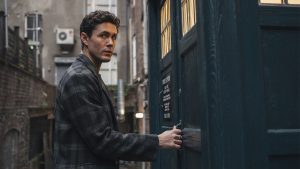
This Rings of Power review contains spoilers.
The Rings of Power season 2 episode 4 is stuffed to the brim with bits and pieces of Tolkien’s lore drawn from all over the place, but of course one new character stands out above all the others: Tom Bombadil, played here by Rory Kinnear.
Tolkien fans have been waiting a long time to see Tom Bombadil onscreen, as he has been cut from nearly every adaptation of The Lord of the Rings, for the unfortunate reason that he does not really have any bearing on the plot. Including him in The Rings of Power is a very good idea, since his character is explicitly stated to be older than anyone else, and he is both wise and powerful. Here he has been given a substantial role in the story that the series is telling, as he is clearly going to help Probably-Gandalf (Daniel Weyman) to learn to control his power and understand who he is.
Including this character also helps to expand the world of the series and vary the tone a bit more. New viewers, or fans of the films who have not read the books, will have no idea who Bombadil is and will not experience the same joy in simply seeing the character brought to life as fans of the books will. But the nature of Bombadil offers a fresh new feeling to the show. He is more mysterious and less overtly comical than the Harfoots (or Stoors), but he is also lighter-hearted and more whimsical than the Elves or Men. Kinnear’s performance works well, being just twinkly enough without overdoing it, and the design of the character, his costume, and his home all fits the character. Bombadil’s speech about how stars are “newcomers” is especially wonderful and it’s lovely to hear so much of Tolkien’s verse and dialogue.
The show’s treatment of Bombadil’s wife Goldberry is a bit odd and is perhaps down to the change in location. In The Lord of the Rings, Tom Bombadil lives next to the river Withywindle, near the Shire, and Goldberry, his wife, is described as “the river-daughter,” that is, presumably, the daughter of the Withywindle River. He is far removed from the Withywindle and surrounded by desert here, which is fair enough considering how many centuries before The Lord of the Rings this story takes place, but perhaps this is why Goldberry appears only as a disembodied voice Bombadil refuses to acknowledge exists.
Interestingly, Old Man Willow, a rather evil willow tree that lives by the Withywindle and tries to eat Merry, Pippin, and Sam, is adapted here as a desert tree in Tom’s new location. This seems to be another example of adapting something in a way that fits the story being told, while keeping the essence of the scene and some of the dialogue from the book. A scene reinstated for the extended editions of Peter Jackson’s The Two Towers shifted this scene of the tree pulling in Merry and Pippin to Fangorn and had them rescued by Treebeard instead of Bombadil. Here Bombadil has been reinstated but it is the Stranger who is rescued. It’s still the same scene, and it’s fun to see.
Tom Bombadil’s appearance is not the only bit of Tolkien lore coming under the spotlight in this episode. We also meet another group of ancestors of the Hobbits in addition to the Harfoots we already know; the Stoors. The Stoors are the ancestors of Gollum, as well as of Merry and the Brandybucks. Although they lived in a different location in the books, near the River Anduin, they were, as they are here, a group who stayed where they were when others went Wandering towards the west to find a new home. They were particularly fond of water, though, which is less clear here as their location has been moved to a desert! Their cave-homes are a rather neat combination of Tolkien’s Hobbits and real-world homes in desert countries, like the traditional Berber homes in North Africa (where Star Wars was filmed).
Tolkien’s lore has the Hobbits’ ancestors (Harfoots, Fallowhides, and Stoors) migrate westward to escape the rise of Sauron in the east. The Harfoots’ backstory in this episode, following a Stoor who left long ago looking for some kind of Promised Land, is a bit more melancholic. It’s a sweet, sad scene, as Nori (Markella Kavenagh) talks about how the Harfoots do not have a home and just keep wandering. It seems a bit of a shame to make the Harfoots’ wandering neither a migration to escape danger, nor a deliberate choice for a nomadic way of life, either of which would resonate with many real-life peoples, but the scene itself is nicely done and the reveal clearly means a lot to Nori.
This episode also establishes that both the Stranger and Ciarán Hinds’ character, the Dark Wizard, are Istari, or Wizards. That narrows down the identity of both to two out of five Wizards mentioned in The Lord of the Rings; Gandalf (the Grey), Saruman (the White), Radagast the Brown, and the two Blue Wizards. We’re reasonably confident that the Stranger is actually Gandalf at this point. While the Dark Wizard could in theory be Saruman, the wizard gone bad from The Lord of the Rings, we think this is unlikely. Gandalf had absolute faith in Saruman right up until he was betrayed by him in The Fellowship of the Ring, and considered him the wisest of the Istari, which would hardly be the case if he had known Saruman was throwing his weight around as a “Dark Wizard” and threatening Harfoots back in the Second Age.
We think the Dark Wizard is much more likely one of the two Blue Wizards, the two we know the least about. Even Tolkien wrote in a letter in 1958 “I really do not know anything clearly about the other two”, though he did say that they were sent east and south to fight Sauron, but failed, and became the founders of “secret cults and ‘magic’ traditions” that outlasted Sauron himself – the sort of cults Tolkien had considered writing a sequel to The Lord of the Rings about, perhaps inspired partly by Greco-Roman mystery cults. A very late note also suggests that they came to Middle-earth earlier than Gandalf, Saruman or Radagast, so it seems almost certain that this Dark Wizard is one of these two. That means the show has an almost clean slate to do what they want with him. His minions, meanwhile, look like they might be ripe for recruiting as Nazgûl once a few more Rings are completed…
Galadriel (Morfydd Clark), despite being the only character in Tolkien’s legendarium to hang on to her Ring from beginning to end, has in this version of events already lent it to Elrond (Robert Aramayo) so he can get away and protect it, while she gets captured by Adar (Sam Hazeldine). Their encounter with the barrow-wights is another delightful example of a bit of The Lord of the Rings that never makes it to screen being adapted, though there is not much similarity between this scene and its counterpart in the novel. Where Frodo, Sam, Merry, and Pippin are captured in a thick fog around mysterious standing stones and taken into barrows, the tombs of long-dead warriors, these glowy-eyed barrow-wights ambush Galadriel, Elrond and their companions in a wood and attack them in a more typical bad-guy style. The glowing eyes are not quite what some of us pictured, but they are nicely creepy and it’s fun to see them.
In other storylines, Arondir (Ismael Cruz Córdova), Isildur (Maxim Baldry), and Estrid’s (Nia Towle) encounter with the monster in the bog is primarily designed to bring Estrid and Isildur closer together after she saves them instead of taking her opportunity to run away, but the most important thing about this scene has nothing to do with that: Arondir made a joke! This is sincere praise of the writing of the episode. Arondir is one of the most dour-faced characters in a sometimes dour-faced show, and it is hard to root for and empathize with characters who are always glum and serious. Without Bronwyn, even his characterization as a romantic hero has been taken away. So this little moment, as he starts what sounds like another Tolkien-faithful but portentous statement – “there are nameless things in the deep places of this world” but follows it up with, “this one we shall call supper” is really important in making him feel like a more fully rounded character.
It is these three who manage to convince an Ent and Entwife who have captured Theo (Tyroe Muhafidin) to let him go, despite the wrongs done to their forest. The Entwife Winterbloom is voiced by Olivia Williams, and the Ent, Snaggleroot, by Jim Broadbent, who is a perfect choice for this particular bit of casting. His voice has the same natural boom to it as John Rhys Davies, who voiced Treebeard in the Peter Jackson movies (as well as playing Gimli the Dwarf).
For long-term Tolkien fans there is something really exciting about seeing one of the lost Entwives in person. They only exist in The Lord of the Rings as long-lost lovers, creatures talked about but never heard or seen, so actually seeing one in action is rather exciting and they are beautifully rendered. We do have one tiny quibble, though. Winterbloom is very literally named, as she is covered in pink blossom while Snaggleroot is not. This uses an old stereotype to identify her as the female one (pink and pretty), but surely, if it is spring, they should both be in blossom, and if it is not spring, neither should be?
This episode’s biggest weakness is the sheer volume of Tolkien’s *stuff* all thrown in together. We can see what the thought process was behind it. We meet Tom Bombadil, and he rescues the Stranger from the eastern version of Old Man Willow just as he rescues the Hobbits in The Lord of the Rings. In the books, Bombadil also saves the Hobbits from Barrow-wights, so let’s throw them in too – but we can’t really put them in Rhûn as well, so let’s have Galadriel and Elrond run into them. And we should have some Ents and Entwives, and Old Man Willow is probably related to them, so let’s put them in here as well, but in a different place and interacting with a different group again. And on top of all of that, there’s also a water monster, who is a bit like the Watcher in the Water that lives outside the gates of Moria in The Lord of the Rings.
Don’t get us wrong – it’s wonderful to see so much of Tolkien’s lore brought to life. We’ve finally had a chance to see Tom Bombadil, and barrow-wights, and Entwives depicted on screen. We would not want to get rid of any of it! We might just have organized the storylines a little bit differently across the episodes, so that each had a bit more time to breathe. Putting Bombadil’s introduction in the same episode as the barrow-wights, but not putting them together, is a brain-twister.
The episode has some major strengths, though. Tom Bombadil is just wonderful, and done perfectly, avoiding any sense of being overly twee and getting across the age and mystery of Tolkien’s character effectively. Both the inclusion of Bombadil and some of the writing elsewhere in the episode lifts the tone. The series is starting to embrace whimsy, humor, and magic, as well as monsters and other creatures – all things that enrich its depiction of Tolkien’s world and stop it from becoming a paint-by-numbers epic fantasy stuck in “battle mode” at all times. And hearing Tom Bombadil’s song over the closing credits is just lovely. More please!
New episodes of The Lord of the Rings: The Rings of Power season 2 premiere Thursdays on Prime Video, culminating with the finale on Oct. 3.
Learn more about Den of Geek’s review process and why you can trust our recommendations here.
The post The Lord of the Rings: The Rings of Power Episode 4 Review – Meet the Stoors appeared first on Den of Geek.










